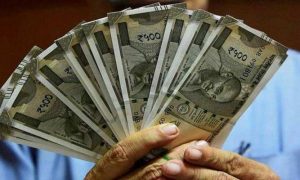By Amit Pabari
What an interesting, challenging, and roller coaster ride kind of a Financial Year 21-22 for Rupee it was. For the year, Rupee ended lower by 3.5% as negative factors dominated over a few positive ones. It was still fortunate as the RBI rescued it by 1.5% by selling a few yards of dollars and announcing sell/buy swaps.
Read More:-IRCTC Update: Indian Railways Cancels 149 Trains Today
Flashback to FY 2021-22:
The fundamentals were divided purely into two parts- In the first half of the Financial Year (Apr to Sept), the Rupee was in the range of 72.30 to 75.60 zone. The fundamentals were in favor of the Rupee as growth was picking up, FIIs deployed almost $5.35 billion, and equities have seen testing lifetime highs. But supply bottlenecks didn’t resolve and thus the US started facing multi-decade high inflation. It took many months for the Fed to understand that inflation was not transitory and they have to lift their support as soon as possible. Finally, the second half of the year was a turning point for the US Fed, global markets and the Rupee too. In October Fed accepted that inflation could persist for a prolonged period of time and for that, they will have to taper down their QE (Bond Buying programme) from Nov to March. And with that EM started facing an outflow from the equity market, FIIs pulled out roughly $21 billion from the Indian market in H2 FY22. Equities started reverting to the mean.
Obviously, higher US rates and yields were not favoring riskier EM and currencies. US DXY was steadily rising on rate hike prospects. The black gold- Crude oil was stepping higher due to rising demand and unresolving supply bottlenecks.
Read More: Avail benefit of Rs 10,000 even on zero balance, know how PM Jan Dhan account holders can do it
By the mid of February, the birth of the Russia-Ukraine war added ‘fuel in the fire’ and ‘fuel in the fuel’ too. In the energy pack, Russia accounts for 11% of crude oil and 17% of natural gas production. They aren’t just a big supplier in the global oil and gas market but also in many other commodities. They have strong command over Agro and fertilizer production too. In reaction to global turmoil due to risk-off sentiment, Rupee depreciated to an all-time low of 76.95 levels. But didn’t sustain there for long as RBI suspended intervention and rescued the same from sliding. They sold roughly $13 billion from reserves and announced a couple of sell/buy swaps worth $5 billion each. With this, Rupee recovered by almost 1.6% and still closed FY22 down by 3.54%.
Amongst EM pack, Rupee lies mostly in the middle of the list of performance. The Rupee depreciated by more than 3.30% from the average EM performance. The Brazilian Real was an outlier with a whooping return of 19% as higher commodity prices supported the net exporting country.
Read More: HDFC Ltd announces merger with HDFC Bank; stocks surge up to 10%—know share distribution arrangement

Outlook for FY22-23:
Surely, a new Financial Year will also have a lot of interesting themes to be watched. Let’s check factors which are likely to go against and in favor of Rupee.
Factors against Rupee this year would be:
Higher inflation: The fuel and food prices account for almost 53% of weightage in the CPI inflation. India’s inflation for the month of February came in at 6.1%, breached the upper bound of RBI’s comfort zone (6%) even before higher fuel prices take effect in India. The hiking wave has begun as the country is witnessing its 12th hike in 14 days after there was no change in the prices for four months since November- taking the total hike to Rs 8.40 a litre. The retail food, grain, pulses are also skyrocketing and thus march inflation to remain elevated near 7 or 8%. Broadly, for the year, we could see a new normal of double-digit inflation in India.
Record trade deficit and Current account deficit: As per the latest data, India’s current account in the three months ended December 2021 widened sharply to a deficit of $23 billion or 2.7% of GDP. Despite India achieving its export target of $400 billion, the widening trade deficit to the record level is likely to remain a big concern.
Read More: PAN-Aadhaar not linked yet? Here’s what you have to do now
Another near record Fiscal deficit: The fiscal deficit for the April-February period stood at Rs 13.16 lakh crore or 82.7% of the revised estimate of 6.9%. For the straight second year in a row, the government is likely to meet its fiscal budget. The government is going to borrow 8.45 trillion rupees in April-September FY23, out of the record borrowing plan of 14.31 trillion rupees. This blowing fiscal target of 6.4% could be headwind for the Rupee.
Hawkish Fed: The majority of the FOMC members have recently indicated a 50 bps hike with a probability of 73% for the same. For the year, the market is expecting 6 quarter basis point hikes. The 2-10 year yield has already inverted to discount everything as on today. The DXY is on the mark to ride above 100 due to both hawkish Fed and risk-off demand.
Uncertainty over Russia-Ukraine war: Even after one month, things are not settling from both the ends. Both Russia and Ukraine are not giving up and thus it is impacting the entire financial markets. The US along with other western allies are increasing their sanctions day by days. Thus, risk-off sentiment is likely to persist and riskier EM FX to be on the toes.
Factors in favor of Rupee would be:
RBI’s reserves and sell/buy swap: As we saw in March, RBI could use their different shashtra to calm down the pressure. So, there would be more selling and announcement of Sell/buy swap to control the Rupee’s value and volatility.
India’s biggest IPO-LIC and other corporate borrowing flows: The most awaited IPO got delayed due to a sudden market sentiment, but likely to be announced soon and could lead to a strong dollar inflows. That apart, many companies have filed IPOs with SEBI and are likely to hit in early FY23. Corporate borrowing related flows could also support Rupee value.

Outlook
A fresh financial year remains interesting for the Rupee as both domestic and global factors remain shaky and gloomy. Surely, the volatility is likely to remain high as flows will be continuously flinging on and off from EM to DM or US treasuries. The DXY is likely to remain stronger on Fed’s multiple hikes. The commodity market is surely under their bull run and will add another fuel to the ongoing inflationary wave. Higher prices create a headwind in front of net importing nations such as India. The payables increase due to higher imports and exports remain doubtful due to supply disruption. Overall, the USDINR pair is likely to depreciate steadily towards 77 to 77.50 over next 2 to 4 months and 78.50 over 6 months. On the downside, support for the pair lies around 75.50 to 75.20 levels and further at 74.80 levels.



































